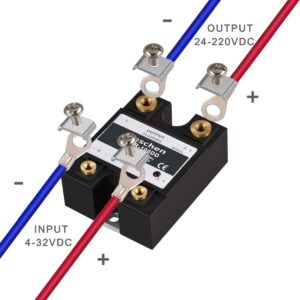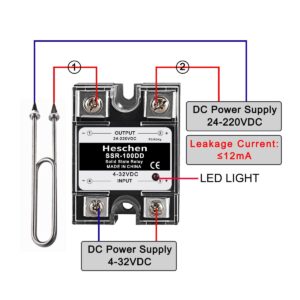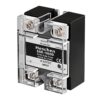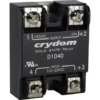ATTENTION! Experience shows that these relays have a higher failure rate, but so far they have not been in continuous operation right from the time of commissioning (Test phase so far approx. 1 year)! Robust semiconductor relay for direct current loads with load voltages between 1…100 volts DC, max. 100A (nominal current – note discounts). Input voltage 4-32VDC. With transparent contact protection cap to ensure compliance with the minimum protection class when used in control cabinet construction IP20. Switching status display via LED when the load is switched. PUK design. Fastening via two holes on a flat, heat-dissipating mounting plate.
Technical specification
| Dimensions | External dimensions approx. 60x48x34mm including contact protection. |
| Circuit type | Contactless thyristor circuit for high switching frequencies. Without mechanical wear! |
| Switching loads | Rated load 100A. The usual deductions for SSR when calculating the actual connected load must be taken into account. |
| Input voltage range | 4-32V DC |
| Load voltage range | 1 …100 VDC |
| Protection class | IP 20 |
| Assembly | On a flat, heat-dissipating surface (mounting plate for control cabinet) using two existing holes, diameter approx. 4.5mm. Distance between the holes approx. 43mm, arranged centrally. |
Application
When designing switching loads, the usual discount factors for SSR relays from the specified nominal load must be taken into account. So are e.g. B. for switching inductive loads (e.g. motors) when using SSR relays, often only 1/8 of the specified nominal load of the SSR has to be taken into account for operation with motors. For ohmic loads, the actual load can usually be up to 20% of the specified nominal load. With medium to high loads and ED >20% (ED = duty cycle), the use of a heat sink to dissipate thermal energy is necessary. As a preventive measure, we generally recommend the use of suitable heat sinks.
![SSR-100DD Relay [SQ Line]](https://shop.g2h.li/wp-content/uploads/2024/02/Heschen_SSR-100DD_1.jpg)
![SSR-100DD Relay [SQ Line] - Image 2](https://shop.g2h.li/wp-content/uploads/2024/01/Anschluss-ssr-100dd.jpg)
![SSR-100DD Relay [SQ Line] - Image 3](https://shop.g2h.li/wp-content/uploads/2024/01/Anschluss-ssr-100dd_2.jpg)










